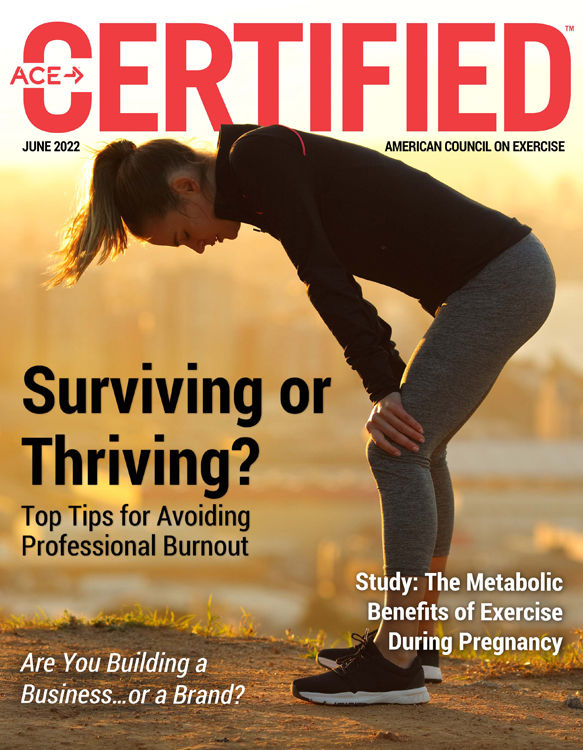
As a health coach or exercise professional, you’re likely no stranger to burnout. After all, success in the fitness industry often relies on adopting a hustle mentality, especially early in your career, when you are encouraged and often excited to take on every new client and seize every opportunity that comes your way. Many people thrive in that type of environment, at least in the short term, but there will likely be (or have already been) times in your career when the workload will become overwhelming, and when you will be doing work that no longer brings you joy, feeds your passion or aligns with your goals and values.
But first, what exactly is burnout? The definition can be tough to pin down, as we all experience it a bit differently. In its 11th Revision of the International Classification of Diseases (ICD-11), the World Health Organization describes it as an “occupational phenomenon,” not a medical condition:
“Burnout is a syndrome characterized as resulting from chronic workplace stress that has not been successfully managed. It is characterized by three dimensions:
- Feelings of energy depletion or exhaustion
- Increased mental distance from one’s job or feelings of negativism or cynicism related to one’s job
- Reduced professional efficacy
Burnout refers specifically to phenomena in the occupational context and should not be applied to describe experiences in other areas of life.”
Another aspect of burnout that confuses the issues is its overlap with depression, the symptoms of which can also include extreme exhaustion, feeling down and reduced performance. As a result, there may be times when you’re unsure if you’re burned out, depressed or simply exhausted. It’s important to again highlight the fact that burnout is work related, so if symptoms extend to low self-esteem, hopelessness or suicidal tendencies, you should consider seeking treatment for depression.
Be Mindful of the Triggers and Signs of Burnout
Erin Nitschke, EdD, NSCA-CPT, an exercise science professor at Laramie County Community College in Wyoming, says that for her, burnout creates “a loss of interest in wanting to pursue something”—a sense of “I have to do this” versus “I get to do this.” It sometimes puts her into a negative headspace that bleeds into other areas of her life, such as not wanting to socialize and take part in activities she typically enjoys.
“There is a difference between ‘burning out’ and being completely burned out,” explains Dr. Nitschke. “They are two very different states of being. Over time, I’ve learned to identify those signs early on, before I allow myself to get to a point where I am truly burned out.”
For Pete McCall, National Director of Fitness Education for EoS Fitness and author of Ageless Intensity: Effective Workouts to Slow the Aging Process and Smarter Workouts: The Science of Exercise Made Simple, burnout stems from a feeling that you always have to be “on” and to be immediately responsive to clients’ questions, social media posts, texts, emails and so on. The hustle mentality can leave health coaches and exercise professionals feeling like they must always be available.
McCall, who also hosts the All About Fitness podcast, points out that there is often a transition in a person’s career, from a time when things like social media morph from being an exciting and fulfilling part of the job to a time when they become tiresome and trigger feelings of self-doubt: “If I’m not posting, am I staying relevant? Am I delivering what my clients or followers have come to expect from me?”
When it comes to identifying triggers of burnout, here are a few questions that you can ask yourself:
- Am I busy for the sake of being busy? People often view maximal productivity as a sign of success and a worthy use of their time, but that’s not always the healthiest approach.
- Am I giving 100% in every area of my life (e.g., as a professional, spouse and parent), while still living a fun, full life, but feel like I’m not doing any of those things well enough?
- Do I often feel like I am not allowed to say “no” to things in my personal or professional life?
By answering those questions thoughtfully and honestly, you may recognize signs that you’re doing too much that falls outside what you’re most passionate about. Of course, not every moment of your day is going to spark joy—some less exciting tasks are simply required to run a business or be a professional—but paying attention to how you answer these questions and how your answers change over time can help you see signs of burnout before they really take hold.
If you are mindful of how you’re feeling about your workload and career at any given moment, you can develop an awareness of whether you’re starting to exhibit signs of impending burnout. Use this strategy for each task (e.g., writing blogs and managing social media), as well as for each type of client you serve, and you may uncover patterns that inform your decision about whether to take on certain types of work or narrow your coaching or training focus in the future. In the long-term, this can steer your career path in a more rewarding direction.
Weigh Opportunities Carefully
It can be difficult to say no when work comes your way, especially if you are new to the industry, work as an independent contractor or own your own business. When considering new opportunities that will add to your workload (e.g., serving on a new committee at work, writing health and wellness blogs or managing your company’s social media presence), it’s vital that you have a strategy for making those decisions. Consider the following questions:
- Does this work align with my goals and values?
- What skills do I have that make me the best person for the job and will allow me to succeed?
- Is the work interesting and engaging? Am I going to learn something new or expand my skillset?
- Will the work build my brand and help me succeed in the long run?
- Does it feed my passion and allow me to do community outreach or serve more people?
- Finally, is the compensation large enough that I simply can’t say no, regardless of how I answered the previous questions?
Of course, not everyone is in a position to be this selective, and sometimes that last question overrides everything else. But, as you grow into your career and continue charting your long-term path, it’s important that you navigate these things strategically and learn to protect yourself from overcommitting and the increased risk of burnout that can result.
Dr. Nitschke describes a feeling where certain things start to “feel like an anchor rather than an opportunity.” Ask yourself: Is this going to weigh me down or lift me up? If you hesitate when offered something, says Nitschke, give the reason behind that hesitation some serious thought.
Also, never forget that you’re allowed to simply say “no.” This is something a lot of young professionals struggle with, as they sometimes fear that each opportunity may be their last. As Dr. Nitschke explains, this requires a mindset shift to understanding that there is sometimes a reward for not doing things, just as there can be a reward for doing them. Also, she highlights the value in learning to say no without having to explain your reasoning, which often leads to a negotiation or additional communication where none is needed. As hard as it can be, she says, there is nothing rude or wrong about simply saying, “No thank you,” or “I need to pass on this opportunity, but I hope you keep me in mind for the future. Thank you for considering me.”
McCall concurs, saying that many people worry that if they turn down work, that opportunity is going to be given to someone else and they may fall behind somehow. But, he warns, saying yes is sometimes the worse option. McCall really focuses on personal and professional growth when weighing opportunities, saying, “If it’s not making you better, it’s making you worse.” Is something really an opportunity if it’s draining your energy, misdirecting you away from other work you are more passionate about or distracting from your long-term goals?
Set Boundaries
McCall also recommends setting some strict boundaries in terms of when you are available to your clients or responding on social media. Working in the fitness industry isn’t your typical 9-to-5 job, but never lose sight of the fact that the work will still be there tomorrow. Few things are truly urgent, no matter what your clients think, or what your gut tells you in the moment. So, set limits on your availability and make your clients aware of those limits.
Being protective of your time is a form of self-care and may help prevent burnout. Don’t be afraid to give yourself a 24-hour reprieve from social media or to shut off your computer all day on Sunday. You may feel like you need to be “on” at all times, but in truth, your clients understand that’s not the case. Think about it this way: Do you expect others to be available to you all the time and at a moment’s notice?
Introduce Variety Where You Can
In an article entitled A Counterintuitive Cure for Burnout, authors Brett and Kate McKay equate burnout to “an oversaturation of sameness.” Every career and lifestyle has a fair amount of routine, no matter how creative or inspiring it may be. In my job as a writer, I get to research topics that interest me, talk to fascinating people, set my own hours and be creative every day. But, as the authors describe, there is a “conveyor belt” element to the job, where the assignments just keep coming, without concern for how easily the words are flowing.
The same is true of the fitness industry. As a health coach or exercise professional, you help people every day, empowering them to live healthy lives and reach their full potential—and this is certainly a rewarding career. But you still have to wake up early each morning; train, coach or teach classes; manage your social media and do other business-related tasks; and get to bed early so you have the energy to do it all again the next day.
To combat sameness and the burnout it can bring, the authors recommend changing things up where you can in other areas of your life, from the foods you eat to the leisure-time activities you participate in. Even changing up your music playlist can provide a boost of energy and offer a reprieve from your routine.
Another way to counter that sense of sameness is to change the way you perform your current job. Are you bored of your training schedule? Add an after-school youth program. Sick of managing payroll? Hire a service to take over that task. Changing things up, whether in small or dramatic ways, can help stave off burnout.
One last note: It’s important to recognize that boredom and burnout are sometimes just a part of life. Not every day is going to be exciting and inspirational. “It’s possible to experience burnout in a job that you generally like, feel well-suited for, and actually want to stay in,” explain the McKays, so don’t panic and feel the need to make sweeping changes in your life at the first signs of burnout. Sometimes, plugging away and staying the course is what’s needed to get you where you want to go.
In Conclusion
The ultimate key to preventing burnout is to be honest and authentic with yourself and those around you. Recognize and then be open about your level of energy and your ability to take on more responsibilities. Be mindful of those things that trigger feelings of being overwhelmed and have strategies in place to protect yourself if signs of burnout begin to appear. Remember, there is nothing selfish about taking care of yourself and your mental health, and it doesn’t serve you or your clients well if you feel dispassionate or burdened by the work you are doing. After all, you can’t lead others to wellness without first being mindful of your own health and well-being.
Expand Your Knowledge
 |
This first-of-its-kind program equips you with the comprehensive science and advanced coaching methods you need to help everyone—from everyday people who are stressed-out and struggling to see results, to elite athletes and top performers who are seeking that extra edge—achieve restorative sleep, manage daily stressors and learn how to recover in ways they never knew existed.
|
 |
Inspire positive lifestyle change within your clients by applying behavior-change strategies. Whether you are coaching clients in chronic pain or stress management, the Improving Wellness Through Behavior Change course bundle has you covered. Learn the latest techniques and strategies to work more effectively with your clients so they can establish healthy habits that last a lifetime.
|
 |
Stress impacts every single cell and system of human body and is often only exacerbated by exercise. In this webinar, ACE Certified Health Coach and Master Trainer Lance Breger guides you through proven stress-reducing exercises to keep in your personal and professional tool box that are drawn from various fields and practices, including psychology, psychiatry, tai chi and yoga.
|





 by
by 





